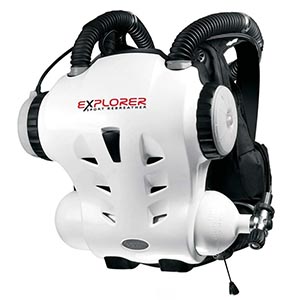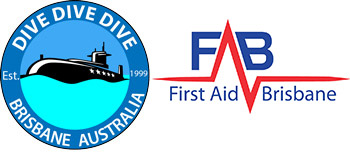Rebreathers, Review
Hollis Explorer Review
 In the late 1990’s I taught the Draeger Dolphin semi closed rebreather. So I was very excited to be able to finally take the TDI Hollis Explorer Diver Course and see how a semi closed hybrid system might bridge the gap between that old technology and new.
In the late 1990’s I taught the Draeger Dolphin semi closed rebreather. So I was very excited to be able to finally take the TDI Hollis Explorer Diver Course and see how a semi closed hybrid system might bridge the gap between that old technology and new.
The first thing you notice about the Explorer is the build quality is very good. The attention to detail by Hollis in providing a great out of the box, ready to dive, user experience is second to none with everything you need included.
Support from an updated manual and a series of instructional videos by Phil Short shot by Jill Heinerth at DEMA 2013 makes this one of the best manufacturer educationally supported rebreather products on the market. Available on You Tube on the Hollis channel it’s worth a look from anyone considering the Explorer.
The start-up sequence is largely automated and provides clear instruction on what diver intervention is needed to safely perform all pre-dive checks. Once the full checks are done, if the system is started up within 2 hours, a cut down version is presented. This would enable fast deployment from a boat arrived onto site for example without the need to spend time again.
After the sequence the Explorer has analysed your nitrox, conducted a positive and uniquely a negative pressure test, checked gas, ADV function and so on. Good to go, you hit the water and although it is intimated that you do not need a separate bail out cylinder when diving shallower than 18m, I always advocate carrying one regardless.
In the water it is comfortable to wear and a Hollis wing and back plate provides plenty of lift. I attached additional third party integrated weight pockets and Hollis provide a weight pocket to attach to the top for trim. The Explorer trimmed out reasonably well and is uncluttered at the front due to rear mounted counter lungs.
Those same counter lungs provide a not so great work of breathing when in the horizontal classical diver position as one cannot deny the laws of physics, but slightly head up and angled it breathes considerably better.
The Bailout valve is excellent, smooth operation and very easy to breathe from as well as comfortable in the mount with a small form factor.
The CO2 sensor is an optional inclusion which adds a level of safety. When present the explorer warns the diver of a potentially fatal situation when carbon dioxide has built up to unacceptable levels indicating an exhausted or compromised scrubber. It also cuts the pre-breathe sequence time built into the handset.
Unfortunately in my dives, the sensor reported back numerous false alarms and after some forced bail outs was eventually removed from the unit. The sensor has received a couple of updates since launch of the initial prototype units and I am confident these teething troubles will be worked out as Hollis have been quick to respond to previous concerns and provided upgraded filters for the sensor.
One of the best things about a fully closed circuit rebreather is the extended no decompression times from breathing optimal partial pressures of oxygen at all phases of the dive. One could think of the rebreather being a portable nitrox blending machine.
The Explorer on the other hand has a single drive gas of up to nitrox 40%. This drive gas is limited as it’s used by the diver directly via the bail out valve in the event of a situation arising that demands the loop be abandoned. It must be directly breathable at depth and the ADV draws from it.
Whilst this enables the diver to get easy fills from anywhere able to provide nitrox, this also limits the partial pressure of oxygen that the diver will breathe. The Explorer injects nitrox into the divers loop to attain a dynamic set point of partial pressure. The user is able to make adjustments to that via handset which effectively controls how often the rebreather fires.
In real terms I found the Explorer on a 10m dive provides a PO2 of around 0.45 or less depending on the DCP the user sets. This is roughly the equivalent of breathing air on open circuit and will produce the same no decompression limits. An open circuit nitrox diver with a mix of 40% would be breathing 0.80, whilst a Poseidon CCR diver would be at 1.0.
In that example the Explorer diver is at a disadvantage in terms of NDL. Moving to depths of 30m the situation changes but the Explorer will still be waving goodbye to and heading to the surface before a best mix nitrox open circuit diver or most certainly a closed circuit diver, either as a function of gas, scrubber or more likely NDL.
Explorer divers ultimately choose between the balancing act of longer, quieter dives that provide less efficient breathing gases for NDL times or shorter, bubblier dives and with better NDL times. This may be changed on the fly by the fantastically readable OLED controller with built in computer.
Rebreathers also have a reputation for silent diving and whilst compared to an open circuit system the Explorer is very quiet, there still remains a small audible stream of bubbles which will vent from the rear periodically. On a 10m dive with the Explorer left on automatic settings this happens is every couple of breaths, or if your adjust it for better NDLs then this can every breath. Not so silent diving.
The scrubber is 1.5kg, which makes it very small by most standards and limited to 2 hours it is claimed. CE testing shows this to be 40 minutes under extreme loading. How the scrubber fairs when breathed hard by an unfit diver at depth I would be curious to see, which is not that strange a concept as this was the driving force behind many sales of the old Draeger systems – those divers who chewed through open circuit gas.
Although advertised as being pre-packed, at the moment these are not available and no ETA has been given to dealers. The suggestion is that for training agencies that demand a pre-pack scrubber to be used, a dive professional may pack the cartridge. As an instructor I personally take exception to this and would liken this to packing someone’s parachute. I would have no way to tell what happened between that leaving the dive store and hitting the water and liability is too great.
My suggestion is that until that is resolved, purchasers might want to look at training that teaches you to pack it yourself, such as the TDI Explorer Diver course. (EDIT – PADI have since decided that great leaps have somehow been made in packing scrubbers so allow this as a part of the PADI Rebreather course. Since the packing procedures have not changed for over a decade, if you were pessimistic you might consider that the timing of Hollis announcing there would be no pre-packed scrubber ever and this by PADI to be more than mere happy coincidence.)
Verdict
The Explorer is a well built and polished product that Hollis has done an outstanding job with. It is tremendously fun to dive and comes at a price point which, for the level of technology provided, is ground breaking.
However, divers looking to get into rebreathers should understand the limitations of the Explorer when compared to fully closed systems in terms of decompression, gas dive time & silent operation. It is those limitations which mean you are unlikely to get a full CCR diver asking to buddy with you and have more gas and time than a single tank diver, but will fair considerable worse than a nitrox sidemount diver. From a technical divers perspective – move along there is nothing to see here and recreational divers should be very cautious in thinking they are buying into the CCR club – you are not – it’s just a clever semi closed.
But comparisons to fully closed systems or open circuit tec rigs are unfair, so for those divers simply wanting a semi closed system to enjoy their current diving with – the Explorer could well be for you and I’ve no doubt it will put a smile on your face as a toy. However, for those seeking a recreational CCR, you might be very wise to consider other systems which provides a substantively better rebreather experience than the Explorer which is not upgradeable.
We shot the Explorer and the Inner Space Systems Corp Pathfinder in action on some of our test dives – enjoy ! Daren
